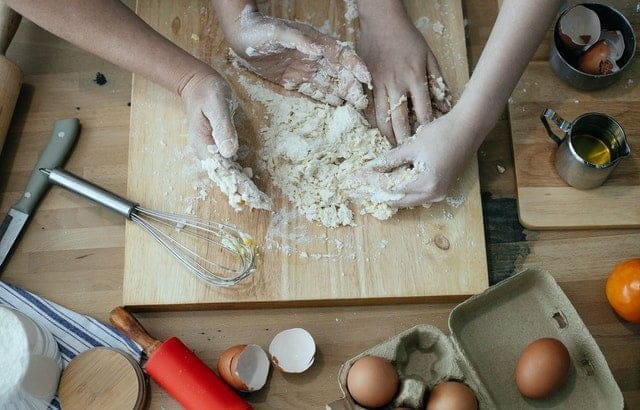Whether you are having a quiet Christmas this year or entertaining the whole family, head chef, Dane, at Guy’s Café Bar and Restaurant has given his five top tips to help take the stress out of your Christmas morning.
Enlist some helpers
If you’re the head of the Christmas kitchen you will probably want to avoid getting tied up scrubbing and peeling potatoes, whisking your Yorkshire pudding batter and washing the pots. If you can, rope in some helpers to take on a task it will really help take the strain off yourself!

The Vegetables
Gone are the days of ‘mums stewed vegetables’ on the Christmas table.
Did you know that to get the most flavour and nutrients from our veggies, other cooking methods outshine a pan of boiling water?
Mix up your roasts! Potatoes and parsnips do not have to be the only roasts on your plate. Try roasting carrots, sprouts, beetroots, red onions and even cauliflower to intensify their flavours.
Don’t forget to add some robust herbs like thyme and rosemary along with some garlic cloves and a little knob of butter to make them shine.
For the full flavour and high nutrient retention, steaming your vegetables is the way to go.
Tis the season, to season! Don’t be afraid to add seasoning after steaming. Sea salt, ground pepper and drizzle of quality Yorkshire pressed rapeseed oil.

The Potatoes
You may have seen, read or overheard the ‘best’ way to get the crispiest roast potatoes.
To allow minimum effort and get maximum results here’s some pointers for perfect potatoes!
- Using whichever is your fat of choic;, duck, goose, vegetable oil or cold pressed rapeseed for the extra omega 3’s. Heat a heavy roasting tray in the oven at 185 degrees C.
- My go to is Maris piper to be the right spud for the job – with Russet or King Edwards being close contenders.
- As your helpers have already peeled and quartered your spuds in advance the next step is the easy bit. Fill a large pan with cold, salted water and bring to the boil with your potatoes. Once the pan is at a rolling boil, turn down the heat and simmer for 3-5 minutes. Check regularly. You’re looking for them to fall easily from a sharp knife when pierced. Drain into colander and allow them to cool slightly and steam off some of the moisture. Shake lightly to ruffle up the outsides (this makes your crispy bits).
- Try to place the potatoes in the roasting tray evenly distributed with their own little roasting space. If they are thrown in or piled up you won’t get the crispness.
- The potatoes are little crispy sponges of goodness, they will absorb what flavours you add to the tray so adding aromatics to the spuds will just lift them. Depending how adventurous you want to be you can add herbs like parsley, rosemary and thyme. Spices such as smoked paprika, cumin and turmeric all bring something new to the humble roastie. For me always use garlic and do not season with salt until finished as this draws out moisture during cooking and impact the crispiness.
- Turn the spuds in the tray regularly until a fluffy centre is achieved around 30-40 minutes in.
- Serve straight away.

The Turkey
Buy the best you can afford.
By choosing locally farmed from a local butcher you’re going to end up with a much better product while supporting local at the same time.
Let’s start by rubbing the skin of the bird with some rapeseed oil and a little seasoning.
Popping the turkey breast-side down for the first hour or so of roasting means the bird essentially bastes itself. If you can manage to turn it a few times throughout the cooking process it will encourage the juices to stay inside.
The use of an oven safe temperature probe will allow you to cook your turkey safely and to perfection. A great investment. The core temperature of the breast of the turkey should reach 70 degrees C and if cooking a whole bird its advised that the leg and thigh is cooked to 75 degrees C.
The heat of the oven forces the juices into the middle of the bird so, once you’ve extracted it from the oven, let the turkey rest for around 20 minutes minimum under some foil before carving it.
The juices will redistribute, and you’ll have moister meat.

Yorkshire Puddings
The simplest and my favourite part of lunch.
Make your batter up an hour or two prior to cooking to allow resting time.
The recipe is simple, equal volumes of plain flour, eggs and whole milk.
For example, one cup, one scoop, one jug as long as the volume of each ingredient is the same they’ll be perfect. A little salt to season. Whisk until smooth and rest in the fridge.
Heat a splash of oil in the pudding tins in a preheated oven at 190 degrees C.
Expect a bit of smoke.
Fill the yorkie tins around 2/3 full and return tray to the oven and cook for around 18-20 minutes.
Here’s the big tip, when the time is up just open the oven slightly and wedge with a damp towel, turn the oven off and just let them rest for a few minutes. This will allow moisture in the oven to escape and not cool the puddings down too fast which would cause the ‘pancake effect’.

Fancy a break from cooking over the festive period?
Join us at Guy’s Café Bar & Restaurant for our Christmas Fayre menu – available from 1st of December – 23rd December
To view our Christmas Fayre Lunch Menu click here
To view our Christmas Dinner Menu click here





